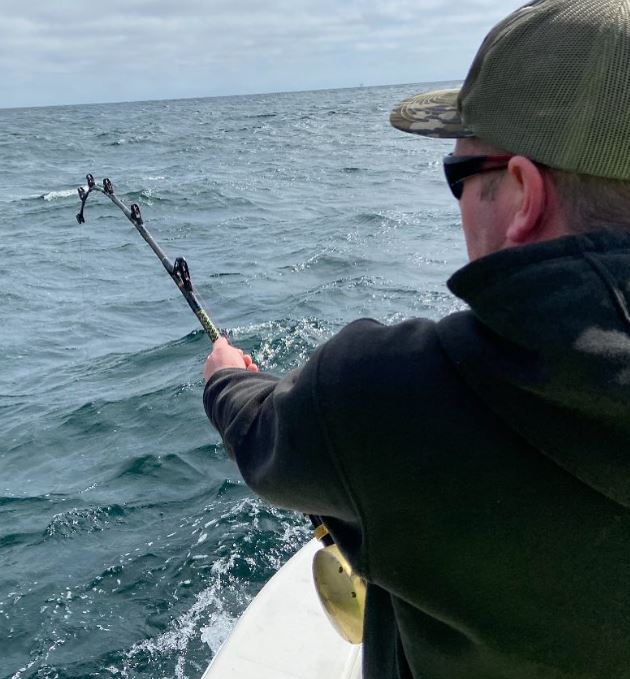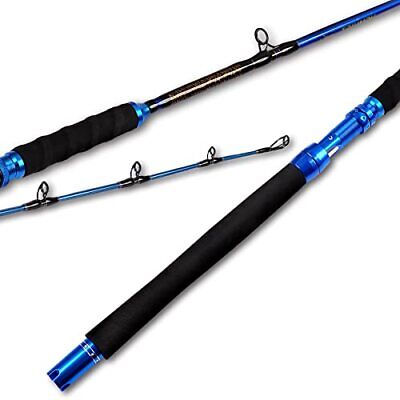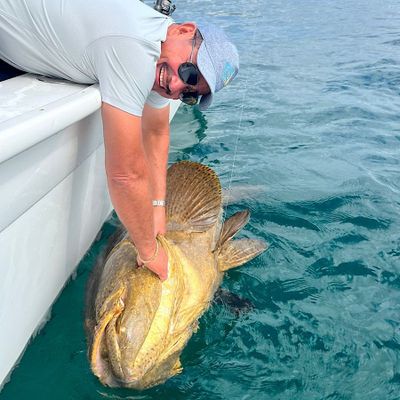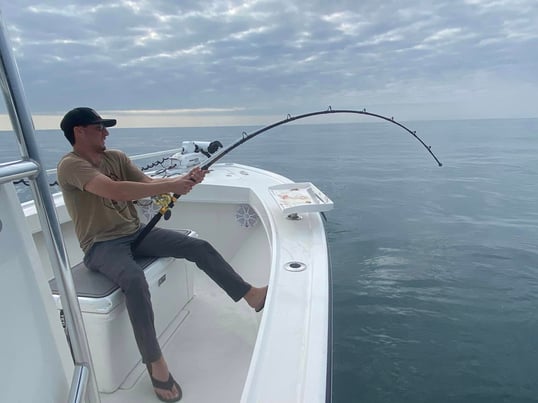Deep sea fishing and inshore fishing differ in terms of location and target species. Deep sea fishing takes place in open waters, targeting larger fish species found in deep ocean depths.
Inshore fishing, on the other hand, takes place near the coast, targeting smaller fish species found in shallower waters. These two types of fishing offer different experiences and challenges for anglers, with deep sea fishing often involving longer boat trips and the pursuit of larger, more elusive fish species, while inshore fishing offers the convenience of being closer to the shore and the chance to catch a variety of smaller fish.
Both types of fishing provide unique opportunities for anglers to enjoy the thrill of the catch and the beauty of the surrounding marine environment.

Credit: www.coastalfishing.com
Deep Sea Fishing: An Exhilarating Adventure
Deep sea fishing is an experience like no other. Heading out to open waters and casting your lines into the deep blue ocean can give you an adrenaline rush like nothing else. The thrill, the excitement, and the anticipation of what awaits beneath the surface make deep sea fishing an exhilarating adventure for anglers of all levels.
Here’s what makes deep sea fishing so special:
The Thrill Of Heading Out To Open Waters
- Heading out to the deep sea gives you a sense of freedom and excitement. The vastness of the open water and the endless possibilities of what you might catch create a thrilling environment.
- The feeling of the wind in your hair, the smell of the salty ocean, and the sound of waves crashing against the boat add to the overall exhilaration of the experience.
- Being away from the coastline and surrounded by nothing but water creates a sense of adventure and adds a touch of mystery to your fishing expedition.
Catching Big Game Fish Like Marlin And Tuna
- One of the main attractions of deep sea fishing is the opportunity to catch big game fish. Species like marlin, tuna, swordfish, and sailfish are commonly found in deeper waters.
- These majestic creatures are known for their size, strength, and speed, putting up a fight that will test your angling skills to the fullest.
- The feeling of reeling in a massive marlin or a powerful tuna is an exhilarating experience that will leave you with stories to tell for years to come.
Equipment And Techniques Used For Deep Sea Fishing
- Deep sea fishing requires specialized equipment and techniques to handle the challenges of fishing in open waters.
- Heavy-duty fishing rods, reels, and lines are necessary to handle the weight and power of big game fish.
- Trolling, a technique where baits or lures are dragged behind a moving boat, is commonly used in deep sea fishing to attract predatory fish.
- Fish finders and depth sounders are essential tools for locating schools of fish and determining the ideal fishing spots.
Deep sea fishing is not just a fishing trip; it’s an adventure that takes you to new depths and challenges you to push your angling skills to the limit. The combination of the thrill of open waters, the chance to catch trophy-sized fish, and the use of specialized equipment makes deep sea fishing a truly exhilarating experience.
So, gear up, prepare for the unknown, and get ready to embark on an unforgettable fishing adventure in the deep sea.
Inshore Fishing: Exploring Calmer Waters
Fishing Close To The Shore Or In Shallow Waters
When it comes to inshore fishing, one of the main differences compared to deep-sea fishing is the proximity to the shore and the choice of shallow waters. Here are the key points to consider:
- Inshore fishing involves casting your line closer to the shore, usually within a few miles, and navigating within shallow waters. This allows you to explore the abundance of fish species that thrive in these areas.
- By fishing close to the shore, you can easily access areas that are not reachable in deep-sea fishing trips. These areas can include marshes, estuaries, river mouths, flats, and mangroves, all of which are prime habitats for many popular inshore species.
- Fishing in the shallow waters presents a unique set of challenges and opportunities. You’ll find an array of fish species like redfish, snook, speckled trout, flounder, and tarpon, among others, that are specifically targeted in these areas.
- Inshore fishing allows for a more hands-on experience. You can visually spot fish cruising in the clear, shallow water, providing an exciting opportunity to sight-fish and make precise casts.
- This type of fishing is often favored by those who prefer a more tranquil and peaceful setting. The calmer waters closer to the shore offer a more relaxed atmosphere and a chance to enjoy the scenery while waiting for the next bite.
Targeting Species Like Redfish And Snook
Inshore fishing opens up a world of possibilities when it comes to targeting specific species. Here are some notable species frequently pursued by inshore anglers:
- Redfish: Also known as red drum, redfish are a prized catch in inshore fishing. They are known for their strength, powerful runs, and a challenging fight, making them a favorite among many anglers.
- Snook: These powerful and aggressive fish are notorious for their exciting acrobatic displays. Snook are highly sought after due to their challenging nature and are known to put up a thrilling fight when hooked.
- Speckled trout: Found in abundance along inshore areas, speckled trout offer a fun and rewarding fishing experience. They are notorious for their tasty white meat and can be caught year-round.
- Flounder: Known for their distinctive flat shape and ability to camouflage, flounders are a popular target for anglers who enjoy the thrill of bottom fishing. They can be found in sandy areas, estuaries, and near submerged structures.
Tips And Tricks For Successful Inshore Fishing
To enhance your inshore fishing experience, here are some valuable tips and tricks to keep in mind:
- Study the tides: Understanding the tidal movements is crucial for successful inshore fishing. Fish tend to feed during specific tidal stages, so plan your trips accordingly to maximize your chances of a good catch.
- Utilize the right bait: Inshore fish have varied diets, so using a range of bait options can increase your success rate. Live bait such as shrimp, mullet, or pinfish are popular choices, but artificial lures can also be effective.
- Be stealthy: In shallow waters, fish can be easily spooked by loud noises or excessive splashing. Move quietly, and take care to avoid sudden disturbances that might scare away your intended catch.
- Adapt to changing conditions: Inshore fishing can be affected by weather, water temperature, and even time of day. Stay flexible and adjust your techniques and locations based on these factors to optimize your chances.
- Practice catch and release: Inshore fishing provides an opportunity to preserve the population of these fish species. Whenever possible, practice catch and release to ensure the sustainability of the ecosystem and the future of inshore fishing.
Inshore fishing offers a unique and thrilling experience for anglers of all skill levels. Exploring calmer waters close to the shore, targeting specific species like redfish and snook, and employing the right techniques are key to a successful inshore fishing adventure.
So gear up, grab your fishing rod, and immerse yourself in the beauty and excitement of inshore fishing!
Choosing The Right Fishing Experience For You
Deep Sea Fishing Vs. Inshore Fishing – Differences
Have you ever been torn between the thrill of deep sea fishing or the simplicity of inshore fishing? Both options offer their own unique experiences and it’s important to consider certain factors before making a decision. In this section, we will explore the key points to help you decide between deep sea and inshore fishing.
Factors To Consider When Deciding Between Deep Sea And Inshore Fishing:
- Differences in cost, time commitment, and convenience:
- Deep sea fishing:
- Cost: Deep sea fishing trips typically tend to be more expensive than inshore fishing. This is due to various factors including the need for specialized equipment, fuel costs, and longer durations spent at sea.
- Time commitment: Deep sea fishing trips are usually longer in duration. They can range from a half-day to multiple days, depending on the location and type of trip. Therefore, if you’re looking for an extended fishing adventure, deep sea fishing might be the way to go.
- Convenience: Deep sea fishing often requires more planning and coordination. It’s important to book the trip in advance, considering weather conditions and availability. Additionally, you might need to travel further to access deep sea fishing spots.
- Inshore fishing:
- Cost: Inshore fishing trips are generally more affordable than deep sea fishing trips. The cost is lower primarily due to the use of smaller boats, less expensive gear, and shorter durations.
- Time commitment: Inshore fishing trips are usually shorter in duration, ranging from a few hours to half a day. This makes it a more suitable option for individuals with limited time or those looking for a quick fishing getaway.
- Convenience: Inshore fishing is often more convenient as the fishing spots are closer to shore, making them easily accessible. Additionally, shorter trip durations make it easier to fit into your schedule.
Highlighting The Benefits And Challenges Of Both Options:
- Deep sea fishing benefits and challenges:
- Benefits:
- Exciting and adventurous experience in the open sea.
- Opportunity to catch larger and more diverse fish species.
- Possibility of encountering marine wildlife such as dolphins, whales, and sharks.
- Challenges:
- Seasickness can be a concern for some individuals, especially during rough sea conditions.
- Longer trip durations may not be suitable for those with limited time or stamina.
- Higher cost can be a barrier for budget-conscious anglers.
- Inshore fishing benefits and challenges:
- Benefits:
- Relaxing and enjoyable experience close to the shore.
- Higher chances of catching a variety of fish.
- Suitable for beginners as well as experienced anglers.
- Challenges:
- Limited access to certain species that reside in deep waters.
- Smaller fish sizes compared to deep sea fishing.
- Crowded fishing spots during peak seasons.
Now that you have a better understanding of the factors to consider and the benefits and challenges of each option, you can make an informed decision. Think about your budget, time availability, and the kind of fishing experience you’re looking for.
Whether you decide to embark on an adventurous deep sea fishing trip or opt for the simplicity of inshore fishing, both options have their own merits. Happy fishing!
Conclusion
To sum up, the differences between deep sea fishing and inshore fishing are evident. Deep sea fishing offers the excitement of venturing into the open ocean, where anglers can target large and impressive game fish. It requires specialized equipment, knowledge, and a sense of adventure.
On the other hand, inshore fishing takes place in shallower waters and is accessible to a wider range of anglers. It offers a more relaxed and leisurely experience, with a focus on targeting smaller species and enjoying the picturesque surroundings.
Each type of fishing has its own charm and appeal, catering to different preferences and skill levels. Whether you prefer the thrill of battling mighty ocean predators or the tranquility of casting your line near the shore, both deep sea and inshore fishing offer unique and memorable experiences for avid anglers around the world.
So, grab your fishing gear, choose your preferred style, and prepare for a rewarding and enjoyable fishing adventure.





